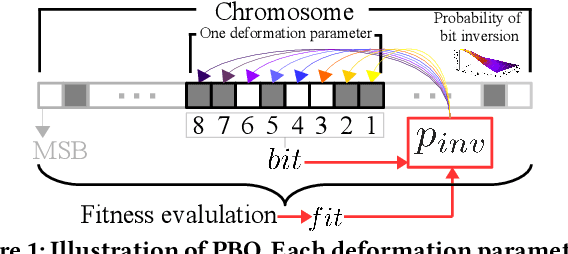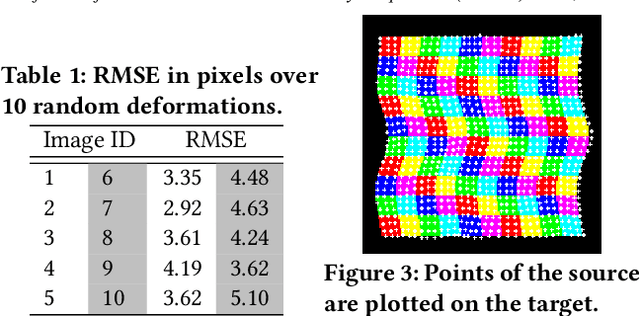Takumi Nakane
Image Deformation Estimation via Multi-Objective Optimization
Jun 08, 2021



Abstract:The free-form deformation model can represent a wide range of non-rigid deformations by manipulating a control point lattice over the image. However, due to a large number of parameters, it is challenging to fit the free-form deformation model directly to the deformed image for deformation estimation because of the complexity of the fitness landscape. In this paper, we cast the registration task as a multi-objective optimization problem (MOP) according to the fact that regions affected by each control point overlap with each other. Specifically, by partitioning the template image into several regions and measuring the similarity of each region independently, multiple objectives are built and deformation estimation can thus be realized by solving the MOP with off-the-shelf multi-objective evolutionary algorithms (MOEAs). In addition, a coarse-to-fine strategy is realized by image pyramid combined with control point mesh subdivision. Specifically, the optimized candidate solutions of the current image level are inherited by the next level, which increases the ability to deal with large deformation. Also, a post-processing procedure is proposed to generate a single output utilizing the Pareto optimal solutions. Comparative experiments on both synthetic and real-world images show the effectiveness and usefulness of our deformation estimation method.
SHX: Search History Driven Crossover for Real-Coded Genetic Algorithm
Mar 30, 2020
Abstract:In evolutionary algorithms, genetic operators iteratively generate new offspring which constitute a potentially valuable set of search history. To boost the performance of crossover in real-coded genetic algorithm (RCGA), in this paper we propose to exploit the search history cached so far in an online style during the iteration. Specifically, survivor individuals over past few generations are collected and stored in the archive to form the search history. We introduce a simple yet effective crossover model driven by the search history (abbreviated as SHX). In particular, the search history is clustered and each cluster is assigned a score for SHX. In essence, the proposed SHX is a data-driven method which exploits the search history to perform offspring selection after the offspring generation. Since no additional fitness evaluations are needed, SHX is favorable for the tasks with limited budget or expensive fitness evaluations. We experimentally verify the effectiveness of SHX over 4 benchmark functions. Quantitative results show that our SHX can significantly enhance the performance of RCGA, in terms of accuracy.
A Probabilistic Bitwise Genetic Algorithm for B-Spline based Image Deformation Estimation
Mar 26, 2019


Abstract:We propose a novel genetic algorithm to solve the image deformation estimation problem by preserving the genetic diversity. As a classical problem, there is always a trade-off between the complexity of deformation models and the difficulty of parameters search in image deformation. 2D cubic B-spline surface is a highly free-form deformation model and is able to handle complex deformations such as fluid image distortions. However, it is challenging to estimate an apposite global solution. To tackle this problem, we develop a genetic operation named probabilistic bitwise operation (PBO) to replace the crossover and mutation operations, which can preserve the diversity during generation iteration and achieve better coverage ratio of the solution space. Furthermore, a selection strategy named annealing selection is proposed to control the convergence. Qualitative and quantitative results on synthetic data show the effectiveness of our method.
 Add to Chrome
Add to Chrome Add to Firefox
Add to Firefox Add to Edge
Add to Edge